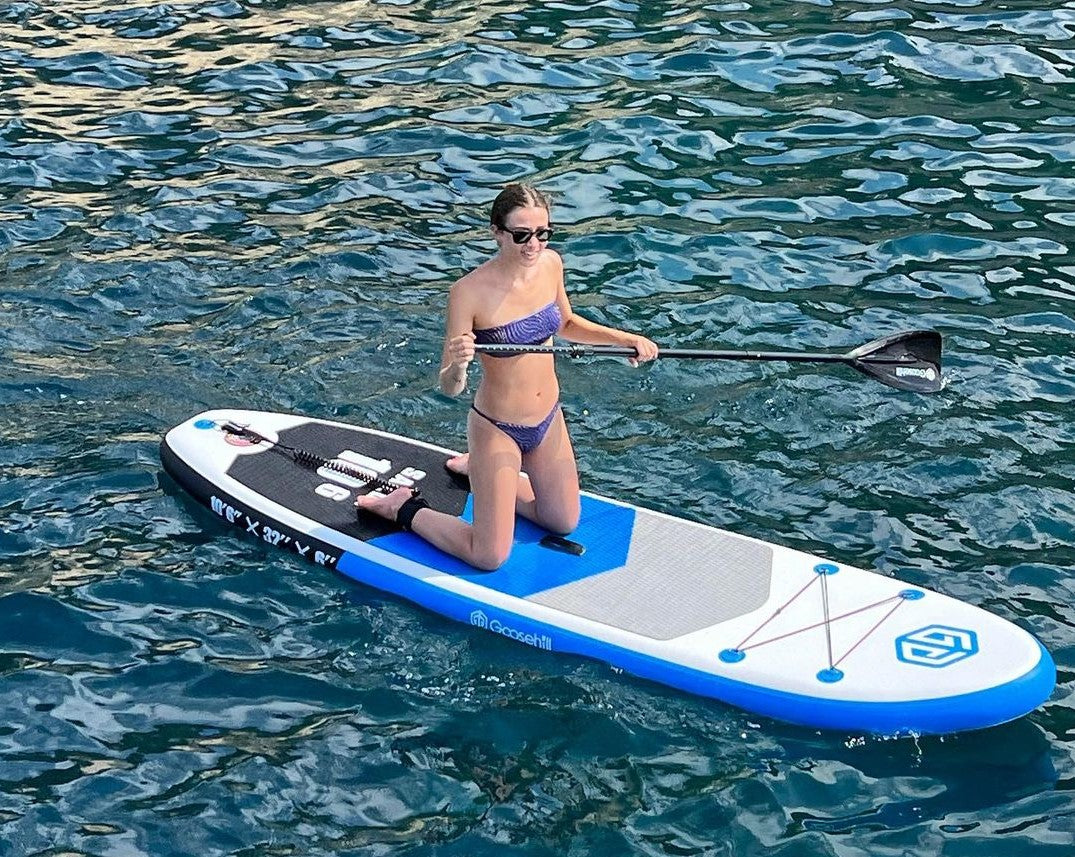2022 Stand up paddle boarding full Guide

Stand up paddle boarding is a fun activity you can do on oceans, lakes, rivers, and bays. It’s a great full body core workout and way to experience the beauty of the outdoors.
Best of all, it’s perfect for people of all ages, body types and skill levels. There’s even enough room to paddle with a dog, friend, child or significant other. Over the years,
paddle boarding has continued to grow in popularity because it gives you the freedom to explore the beautiful waters the surround our planet.
Before paddle boarding for the first time, there are a few basics, techniques, and helpful tips to learn. We’re breaking down everything you need to know including:
1.Types of SUPs
2.Basic paddle board equipment
3.How To Size Your SUP Paddle
4.How to stand up on a SUP
5.Paddling techniques
6.Best paddle boarding tips
7.How to transport your paddle board
1. TYPES OF SUPS
Stand up paddle boards come in all shapes and sizes. The most common type of paddle board is your traditional epoxy paddle board aka hard paddle board. An epoxy paddle board
is fiberglass wrapped around an EPS foam core, with one or more fins to help the board track in the water.
In 2014, a new paddle board construction was born – inflatable paddle boards. Today, inflatable paddle boards are super popular. Inflatable SUPs are great stand up paddle boards
because they provide many benefits that epoxy paddle boards do not. However, both types of paddle boards are great options depending on your lifestyle and needs. Which one is right for you?
A stand up paddle board is much thicker than your average surfboard. Paddle boards typically range from 8 to 12 feet in length, 28 to 32 inches wide, and 4 to 5 inches thick.
Beginner paddler boarders should choose a wider, longer and thicker board. This will offer the greatest stability to learn the paddle board basics on a flat body of water. As you gain experience,
you can progress to a smaller paddle board. The most common SUP shape for beginners is an All-Around paddle board. However, there are a few different types and shapes of paddle boards to consider.
*ALL AROUND SUPS
*INFLATABLE SUPS
*FISHING SUPS
*YOGA SUPS
*TOURING SUPS
*SURF SUPS
2. BASIC PADDLE BOARD EQUIPMENT
(1) SUP ELECTRIC PUMP
(2) STAND UP PADDLES
(3) SUP LEASH
(4) SUP BOARD BAGS
PADDLE BOARD LIFE VEST – PFD (PERSONAL FLOATATION DEVICE)
If you use your stand up paddle board beyond the limits of a paddling , surfing, or recreational use, the U.S. Coast Guard requires you to have a USCG-approved life vest. It’s important to understand the Life
Vest Safety Laws before you get out on the water. Learn more from the WPA (World Paddle Association).
3. HOW TO SIZE YOUR SUP PADDLE
There are several correct ways to size your SUP paddle. Correctly sizing your SUP paddle will vary from person to person and the type of paddling you plan on doing. Your paddle’s length should be customized to:
*How tall you are
*Your arm length
*Your paddle board’s height above the water (epoxy, inflatable, soft top)
*The type of paddle boarding you plan on doing (recreational, touring, surfing, racing)
*There are four SUP paddle sizing methods for you to try out. One method may work better than the other. Find the method that will provide you with the most comfort and paddle efficiency.
4. HOW TO STAND UP ON A SUP
Always start in calm, flat water with a nice wide board. We recommend using a 30-inch board that is about 11 feet long for all SUP beginners.
The board should feel comfortable and not unstable when standing up. If it still feels too unstable after several attempts to gain your balance, try a larger, wider paddle board.
FOLLOW THESE STEPS TO STAND UP ON A SUP:
Get the board out into in water so the fin is free from hitting the bottom
Start in a kneeling position – on your knees take a few strokes on each side of the board
Slowly, stand up with one foot at a time and stay in the middle of the board with your feet parallel to the stringer – about shoulder width apart
Keep a slight bend in the knees and your core centered over the board
Keep in mind you may fall off, when you do, hop back up and try again. If you get cold easily, we recommend wearing a thin wetsuit.
5. PADDLING TECHNIQUES
There are a few basic philosophies on paddle technique, but all revolve around using your paddle as a lever. Your top hand will be
driving the lever and the bottom hand will act as the pivot point.
HOW TO PADDLE FORWARD
Keep your bottom arm straight and paddle boarding relatively still.
Pull your top arm toward your body to extend the paddle forward.
Rotate your top shoulder forward and extend your reach.
Insert the paddle into the water as far forward as possible and bury the paddle into the water.
Rather than pulling you paddle through the water, think about pulling past your paddle.
To stay in a straight line, take a few strokes on one side then switch to a few strokes on the other.
SUP Beginner Tip: Always remember to switch the position of your hands when your paddle changes sides to efficiently paddle your SUP.
HOW TO PADDLE: TURNING WITH THE FORWARD SWEEP STROKE
To turn left, place the paddle in the water on the right side. At the same time, turn your torso to the left side.
Keep a low stance and pull to the right, towards the tail with the paddle, while twisting and leaning to the left with your torso. You’ll feel the board shift to the left quickly.
Related Article From Goosehill SUP: 10 essential paddle board accessories you might not know